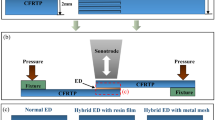Abstract
The hybrid laminar composite stack of carbon fiber reinforced polymer (CFRP) and titanium (Ti) are widely used in several critical engineering applications, including aerospace and automobile sectors. The joining of CFRP and Ti through conventional methods has several limitations such as weight additional, material damage, and lower fatigue life. Ultrasonic additive manufacturing (UAM) is a solid-state manufacturing process capable of joining layers of dissimilar materials. Experimental studies have successfully demonstrated the welding of CFRP and Ti through UAM process. However, there is a lack of understanding of the exact bonding process and influence of process parameter on weld quality during UAM. The present study investigates the bonding process and the effects of critical parameters in the UAM process of CFRP and Ti layers using finite element analysis and simulation technique. The simulation study reveals that the CFRP/titanium stacks encounter interfacial cyclic shear stresses and shear strains. The study found that the vibrational amplitude and surface roughness of the substrates play a critical role in achieving a proper weld. The simulation results are validated using experimentation. The finding of this study can help advance the commercialization of UAM process for welding dissimilar materials and composites.






















Similar content being viewed by others
References
Zhang L, Liu Z, Tian W, Liao W (2015) Experimental studies on the performance of different structure tools in drilling CFRP/Al alloy stacks. Int J Adv Manuf Technol 81(1-4):241–251
Lv J et al (2016) Study on process and mechanism of laser drilling in water and air. Int J Adv Manuf Technol:1–9
Sonate A, Vepuri D, James S (2017) Study of micro ultrasonic machining of CFRP/Ti stacks. in ASME 2017 International Mechanical Engineering Congress and Exposition. American Society of Mechanical Engineers
Tsao C (2008) Thrust force and delamination of core-saw drill during drilling of carbon fiber reinforced plastics (CFRP). Int J Adv Manuf Technol 37(1):23–28
James S et al (2018) Experimental and simulation study of ultrasonic additive manufacturing of CFRP/Ti Stacks. in ASME 2018 13th International Manufacturing Science and Engineering Conference. American Society of Mechanical Engineers
James S, Sonate A (2017) Experimental study on micromachining of CFRP/Ti stacks using micro ultrasonic machining process. Int J Adv Manuf Technol:1–9
Wolcott PJ, Dapino MJ (2017) Ultrasonic additive manufacturing. In: Additive Manufacturing Handbook: Product Development for the Defense Industry. CRC Press/Taylor and Francis Boca Raton, Florida
James S, Rajanna P (2018) Molecular dynamics simulation study of ultrasonic powder consolidation process. in ASME 2018 13th International Manufacturing Science and Engineering Conference. American Society of Mechanical Engineers
Dehoff R, Babu S (2010) Characterization of interfacial microstructures in 3003 aluminum alloy blocks fabricated by ultrasonic additive manufacturing. Acta Mater 58(13):4305–4315
Schick D et al (2010) Microstructural characterization of bonding interfaces in aluminum 3003 blocks fabricated by ultrasonic additive manufacturing-methods were examined to link microstructure and linear weld density to the mechanical properties of ultrasonic additive manufacturing. Weld J 89(5):105S
Friel RJ, Harris RA (2013) Ultrasonic additive manufacturing–a hybrid production process for novel functional products. Procedia CIRP 6:35–40
Sridharan N, Norfolk M, Babu SS (2016) Characterization of steel-Ta dissimilar metal builds made using very high power ultrasonic additive manufacturing (VHP-UAM). Metall Mater Trans A 47(5):2517–2528
Fujii HT, Sriraman M, Babu S (2011) Quantitative evaluation of bulk and interface microstructures in Al-3003 alloy builds made by very high power ultrasonic additive manufacturing. Metall Mater Trans A 42(13):4045–4055
Parmar M, James S (2018) Experimental and Modeling study of liquid-assisted—laser beam micromachining of smart ceramic materials. J Manuf Mater Process 2(2):28
Doumanidis C, Gao Y (2004) Mechanical modeling of ultrasonic welding. Weld J-N Y 83(4):140-S
Zhang CS, Li L (2010) Effect of substrate dimensions on dynamics of ultrasonic consolidation. Ultrasonics 50(8):811–823
Abubakar AA, Khan SM, Mekid S (2017) On the modeling of fibers embedding in aluminum using ultrasonic consolidation. J Eng Mater Technol 139(3):031003
Sun K et al (2018) Adaptive fuzzy control for non-triangular structural stochastic switched nonlinear systems with full state constraints. IEEE Trans Fuzzy Syst
Qiu J, Sun K, Wang T, Gao H (2019) Observer-based fuzzy adaptive event-triggered control for pure-feedback nonlinear systems with prescribed performance. IEEE Trans Fuzzy Syst:1
Funding
The authors received financial support from the College of Engineering and Computer Science at the California State University Fullerton.
Author information
Authors and Affiliations
Corresponding author
Additional information
Publisher’s note
Springer Nature remains neutral with regard to jurisdictional claims in published maps and institutional affiliations.
Rights and permissions
About this article
Cite this article
James, S., De La Luz, L. Finite element analysis and simulation study of CFRP/Ti stacks using ultrasonic additive manufacturing. Int J Adv Manuf Technol 104, 4421–4431 (2019). https://doi.org/10.1007/s00170-019-04228-6
Received:
Accepted:
Published:
Issue Date:
DOI: https://doi.org/10.1007/s00170-019-04228-6




